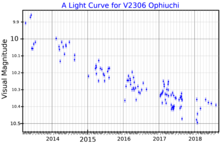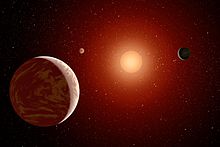 Location of Wolf 1061 in the constellation Ophiuchus | |
| Observation data Epoch J2000 Equinox J2000 | |
|---|---|
| Constellation | Ophiuchus |
| Right ascension | 16 30 18.0584 |
| Declination | −12° 39′ 45.325″ |
| Apparent magnitude (V) | 10.07 (10.05 - 10.10) |
| Characteristics | |
| Spectral type | M3.5V |
| U−B color index | +1.20 |
| B−V color index | +1.57 |
| Variable type | BY Draconis |
| Astrometry | |
| Radial velocity (Rv) | −21.22 km/s |
| Proper motion (μ) | RA: −94.212 mas/yr Dec.: 1,183.679 mas/yr |
| Parallax (π) | 232.1390 ± 0.0268 mas |
| Distance | 14.050 ± 0.002 ly (4.3078 ± 0.0005 pc) |
| Absolute magnitude (MV) | 11.87 |
| Details | |
| Mass | 0.304±0.007 M☉ |
| Radius | 0.319±0.007 R☉ |
| Luminosity (bolometric) | 0.0110±0.0001 L☉ |
| Luminosity (visual, LV) | 0.0015 L☉ |
| Temperature | 3,307+38 −36 K |
| Metallicity | −0.09±0.09 dex |
| Rotation | 95 d |
| Other designations | |
| BD−12°4523, G 153-058, GCTP 3746.00, GJ 628, HIP 80824, LHS 419, Vys 164 | |
| Database references | |
| SIMBAD | data |
Wolf 1061 (also known as HIP 80824 and V2306 Ophiuchi) is an M-class red dwarf star located about 14.1 light-years away in the constellation Ophiuchus. It is the 36th-closest-known star system to the Sun and has a relatively high proper motion of 1.2 seconds of arc per year. Wolf 1061 does not have any unusual spectroscopic features.
The star

Wolf 1061 was first cataloged in 1919 by German astronomer Max Wolf when he published a list of dim stars that had high proper motions. Wolf 1061's name originates from this list. A seven years study found no evidence of photometric transits and confirms the radial velocity signals are not due to stellar activity. The habitable zone estimate for the system lies between approximately 0.1 and 0.2 AU from the star.
Planetary system

In December 2015, a team of astronomers from the University of New South Wales announced the discovery of three planets orbiting Wolf 1061. The planets were detected by analyzing 10 years of observations of the Wolf 1061 system by the HARPS spectrograph at La Silla Observatory in Chile. The team used archive radial velocity measurements of the star's spectrum in the HARPS data and, along with 8 years of photometry from the All Sky Automated Survey, discovered two definite planets with orbital periods of around 4.9 and 17.9 days and a very likely third with a period of 67.3 days.
All three planets have masses low enough that they are likely to be rocky planets similar to the inner planets of the Solar System although their actual sizes and densities are currently unknown. However, this information could be determined if the planets happen to transit in front of Wolf 1061 when viewed from Earth. Because all three planets orbit close to the star and have short orbital periods, there is a chance that this will occur. The University of New South Wales team estimated the chances of a transit at around 14% for planet b, 6% for planet c, and 3% for planet d.
One of the planets, Wolf 1061c, is a super-Earth located near the inner edge of the star's habitable zone, which conservatively extends from 0.11 to 0.21 AU, or at most from 0.09 to 0.23 AU. It is one of the closest known potentially habitable planets to Earth after Proxima b, Ross 128 b, and Luyten b. The next planet out, Wolf 1061 d, could be marginally habitable depending on its atmosphere's composition as it orbits just beyond the habitable zone.
In March 2017, another team of astronomers re-analyzed the system using the HARPS spectrograph. They found planets b and c to be quite similar to their originally reported parameters, but found that planet d was more massive and in a larger, more eccentric orbit. The team was also able to find updated parameters for the host star. Their results showed that Wolf 1061 c is slightly smaller, yet closer to the inner edge of the habitable zone.
| Companion (in order from star) |
Mass | Semimajor axis (AU) |
Orbital period (days) |
Eccentricity | Inclination | Radius |
|---|---|---|---|---|---|---|
| b | ≥1.91 ± 0.25 M🜨 | 0.0375 ± 0.0012 | 4.8869 ± 0.0005 | 0.15 −0.10 |
— | 1.2 (estimated) R🜨 |
| c | ≥3.41 −0.41 M🜨 |
0.0890 ± 0.003 | 17.8719 ± 0.0059 | 0.11 −0.07 |
— | 1.45 (estimated) R🜨 |
| d | ≥7.7 −1.06 M🜨 |
0.470 ± 0.016 | 217.21 −0.52 |
0.55 −0.09 |
— | 2.2 (estimated) R🜨 |
See also
References
- ^ Gaia Collaboration; Brown, A. G. A; Vallenari, A; Prusti, T; De Bruijne, J. H. J; Mignard, F; Drimmel, R; Babusiaux, C; Bailer-Jones, C. A. L; et al. (2016). "Gaia Data Release 1. Summary of the astrometric, photometric, and survey properties". Astronomy & Astrophysics. 595: A2. arXiv:1609.04172. Bibcode:2016A&A...595A...2G. doi:10.1051/0004-6361/201629512. S2CID 1828208.
- ^ Kane, Stephen R.; et al. (February 2017), "Characterization of the Wolf 1061 Planetary System", The Astrophysical Journal, 835 (2): 9, arXiv:1612.09324, Bibcode:2017ApJ...835..200K, doi:10.3847/1538-4357/835/2/200, S2CID 30738573, 200.
- ^ Samus, N. N.; Durlevich, O. V.; et al. (2009). "VizieR Online Data Catalog: General Catalogue of Variable Stars (Samus+ 2007-2013)". VizieR On-line Data Catalog: B/GCVS. Originally Published in: 2009yCat....102025S. 1. Bibcode:2009yCat....102025S.
- ^ Astudillo-Defru, Nicola; Forveille, Thierry; Bonfils, Xavier; Ségransan, Damien; Bouchy, François; Delfosse, Xavier; et al. (2017). "The HARPS search for southern extra-solar planets. XLI. A dozen planets around the M dwarfs GJ 3138, GJ 3323, GJ 273, GJ 628, and GJ 3293". Astronomy and Astrophysics. 602. A88. arXiv:1703.05386. Bibcode:2017A&A...602A..88A. doi:10.1051/0004-6361/201630153. S2CID 119418595.
- Mermilliod, J.-C. (1986), "Compilation of Eggen's UBV data, transformed to UBV (unpublished)", Catalogue of Eggen's UBV Data. SIMBAD, Bibcode:1986EgUBV........0M.
- Nidever, David L.; et al. (August 2002), "Radial Velocities for 889 Late-Type Stars", The Astrophysical Journal Supplement Series, 141 (2): 503–522, arXiv:astro-ph/0112477, Bibcode:2002ApJS..141..503N, doi:10.1086/340570, S2CID 51814894.
- Brown, A. G. A.; et al. (Gaia collaboration) (2021). "Gaia Early Data Release 3: Summary of the contents and survey properties". Astronomy & Astrophysics. 649: A1. arXiv:2012.01533. Bibcode:2021A&A...649A...1G. doi:10.1051/0004-6361/202039657. S2CID 227254300. (Erratum: doi:10.1051/0004-6361/202039657e). Gaia EDR3 record for this source at VizieR.
- ^ Pineda, J. Sebastian; et al. (September 2021). "The M-dwarf Ultraviolet Spectroscopic Sample. I. Determining Stellar Parameters for Field Stars". The Astrophysical Journal. 918 (1): 23. arXiv:2106.07656. Bibcode:2021ApJ...918...40P. doi:10.3847/1538-4357/ac0aea. S2CID 235435757. 40.
- ^ Wright, D. J; Wittenmyer, R. A; Tinney, C. G; Bentley, J. S; Zhao, Jinglin (2016). "Three Planets Orbiting Wolf 1061". The Astrophysical Journal Letters. 817 (2): L20. arXiv:1512.05154. Bibcode:2016ApJ...817L..20W. doi:10.3847/2041-8205/817/2/L20. S2CID 52320394.
- "ASAS-SN Variable Stars Database". ASAS-SN Variable Stars Database. ASAS-SN. Retrieved 6 January 2022.
- Wolf, M. (June 1919). "Katalog von 1053 staerker bewegten Fixsternen (Catalog of 1053 moving fixed stars)". Veroeffentlichungen der Badischen Sternwarte zu Heidelberg (in German). 7 (10): 195–219. Bibcode:1919VeHei...7..195W.
- "Astronomers discover closest potentially habitable planet: Wolf 1061c". ScienceAlert.com. 17 December 2015. Retrieved 17 December 2015.
- Davison, Cassy L.; White, Russel J.; Henry, Todd J.; Riedel, Adric R.; Jao, Wei-Chun; Bailey III, John I.; Quinn, Samuel N.; Justin R., Cantrell; John P., Subasavage; Jen G., Winters (2015). "A 3D Search for Companions to 12 Nearby M-Dwarfs". The Astronomical Journal. 149 (3): 106. arXiv:1501.05012. Bibcode:2015AJ....149..106D. doi:10.1088/0004-6256/149/3/106. S2CID 9719725.
- Stuart Gary (17 December 2015). "Potentially habitable super-Earth discovered orbiting star 14 light years from Earth". ABC News (Australia).
External links
- "Wolf 1061". SIMBAD. Centre de données astronomiques de Strasbourg.
- Simulated view of the Wolf 1061 system created by the University of New South Wales
| Wolf 1061 system | ||
|---|---|---|
| Stars |  | |
| Planets | ||
| ← Celestial objects within 15–20 light-years | |||||||||||
|---|---|---|---|---|---|---|---|---|---|---|---|
| |||||||||||
| |||||||||||
| |||||||||||
| |||||||||||
| |||||||||||
| |||||||||||